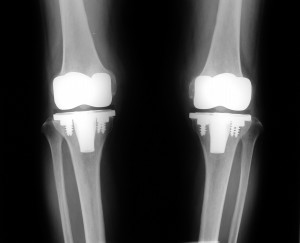
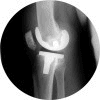
HOME > ENGLISH > PAINFUL LESION > Painful Knees > MITKA
TSUJI ORTHOPAEDIC INSTITUTE
PAINFUL LESIONIn such patients, surgical treatment of choice is total knee arthroplasty(TKA).
In the United States and in Japan, it is the gold standard of treatment in these decades. We place the cobalt-chrome alloy as the femoral component because is rigid and hardly wear. We then place the titanium-alloy as the tibial component because
titanium is more favored by the bone for bone ingrowth. We then place the cross-link ultra high molecular weight polyethylene which is more durable then the one before. And we finish by placing the ultra high molecular weight polyethylene over the
surface of patella.
Minimally Invasive Total Knee Arthroplasty
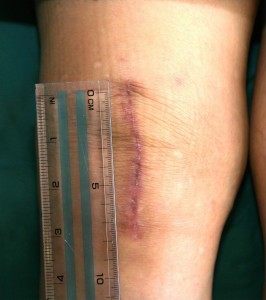
Total knee arthroplasty can also be made by MIS - Minimally Invasive Surgery- like total hip arthroplasty. If you want to cut the tibia from the front for correct bone cut, you may need eight to nine centimeter incision. If you accept cutting the tibia from the lateral side, you can minimize it down to six to seven centimeters with some special tools. Our preference is to make the tibial bone cut in front from anterior because we want a reproducible result avoiding varus-valgus malalignment.
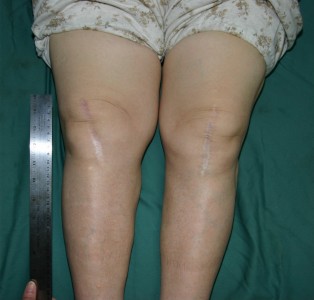
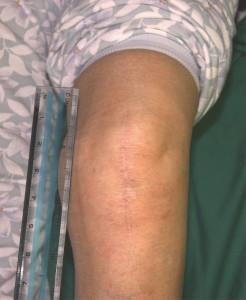
These two pictures are the ones showing ten-year post-operative wound as big as eleven to thirteen centimeters. We were encouraged with the success of minimally invasive total hip arthroplasty (MITHA) and we wanted the similar advancement for the knees. We have developed and/or modified some conventional surgical instruments and reconsidered the order of the osteotomy and finally made it possible to do the operation with eight to nine centimeter skin incision while still making the tibial cut from front for correct osteotomy.
Here I show the surgical procedure of the minimally invasive total knee arthroplasty (MITKA).












Ambulation one week post MITKA
(HDTV wmv)
SITE MAP
#HOME-Dedication
#PAINFUL LESION
-Osteoarthritic Knee-Minimally Invasive Total Knee Arthroplasty(Full Flexion Knees)-10yr. F/U-Intra-Op. Photo
-Osteoarthritic Hip-THA(Video movie)-Cemented THA-Minimally Invasive Total Hip Arthroplasty
-Acetabular Dysplasia-JSN-Acute Destruction-Dial Osteotomy-8yr. P.O.-Recent Development
-Humeral Head Fracture-DJD Shoulder-Humeral Head Prosthesis
-Cuff Tear Arthropathy-RCT-Cuff Repair
#TOUR
-Minneapolis-Sears Tower-Skyscrapers-Stream of Lights-Niagara Falls-The Lady-U of M-OR-Mt. Rushmore-AAOS-LA from Hollywood-Walt Disneyland-Grand Canyon-Downtown Minneapolis-Kind Doctor-Linda
#LOCATION(Location-Map by Its-mo Guide Map by MapFan)